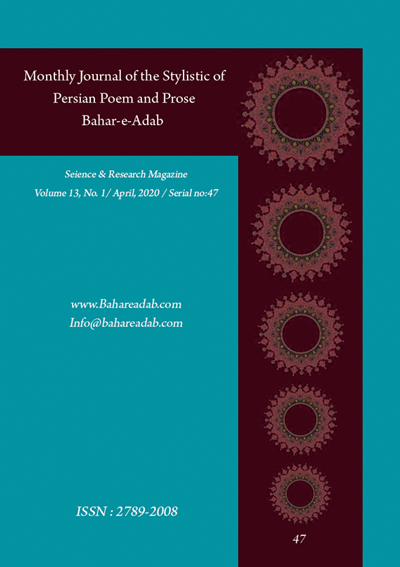- Count View : 457
- آدرس کوتاه شده مقاله: https://bahareadab.com/article_id/321
Journal of the stylistic of Persian poem and prose
volume Number 13،
number In Volume 1،
،
issue Number 47
Studying representation techniques in Shahnameh, with emphasis on the element of “Emotion”
Giti Imani , Behnaz Payamani (Author in Charge), Aliasghar Bavand Shahryari
Abstract
Immortality of Shahnameh is due to the representation of "Emotional Me" that comes from the Great individuality, described in conjunction with the mythology in a deep and mysterious semantic system. "Emotional Me" indicates the identity of each agent. "Emotional Me" is more represented in the lament; because the enthusiastic "Emotional Me" at the laments is a good place to evaluate and reflect the represented me. The subject of the present essay is to examine the reflection of emotional me in the laments of Shahnameh. The lamens in the Shahnameh are analyzed in a case, after explaining the framework of the research and clarifying the types of emotions based on psychological typology –“Limited Human Me”, “Social Me”, “Transcendental me”. The result is that in Shahnameh, men’s mournings are reflected more than the women’s. Firdousi composes the shahnameh with morality and spirituality, and thus the transcendental emotional me is seen in the shahnameh, especially in the behavioral actions of Rustam, Siavash, Feraydoon, and sometimes Rudabeh. Generally, Turanians have shown in the three reactions of "anger and hatred", "sin and despair", "denial and regret" in the grief of their loved ones, that reflected their limited me. In the Persian’s laments, "social me" and "transcendental me" are more represented. The alignment of reflected “me”s with the characters of Shahnameh demonstrates the success of Firdousi’s success in the storytelling.
Keyword
Firdousi’s Shahnameh
, Lament
, Emotional Me
, Immorality
- Shafiee Kadkani, Mohammad Reza (2001) Persian Poetry Periods; From Constitutionalism to the Fall of the Monarchy, Tehran:Elmi Publication.
- Motamedi, Gholam Hossein (2011) Man and Death; An Introduction to Mortality, Tehran: Markaz.
- Pourkhaleghi Chatroudi, M. and Haghparast, L (2010) A Comparative Study of Mourning Rituals in Shahnameh and Historical Remains _Religious mourning in ancient Iran, Journal of Literature and Language, No. 24, p. 63.
- Kobler Ross, Elizabeth (2000), The End of the Road (About Death), translated by Ali Asghar Bahrami, Tehran: Roshd.
- Jung, Carl Gustav (1997), Four Examples, Translated by Parvin Faramarzi, Mashhad: Astan Quds Razavi.
- Yavari, Hora (2008), Psychoanalysis and Literature, Tehran: Sokhan.
- Shamisa, Sirus (2002), Stylistics of Prose, Tehran: Mitra.
- Rastegar Fasaei, Mansour (1995), Mourning of Ashura Songs (Lamentation) in Persian Literature, Tehran: Publishing Institute Emam.
- Ferdowsi, Abolghasem (1995) Shahnameh, by Saeed Hamidian, Tehran: Dad.
- Shafiee Kadkani, Mohammad Reza (1996), Imagination in Persian Poetry, Tehran: Agah.
- Hartman, Ernest (2001) Nightmare; Psychology and Biology of Horror Dreams, translated by Yavar Dehghani, Tehran: Amirkabir.
- Shafiee Kadkani, Mohammad Reza (2006) Poetry Music, Tehran: Agah.
- Kazazi, Mir Jalaluddin (2006), Ancient Letter, Tehran: Samat.
- Schultz, Devan (2011), Personality Theories, translated by Yahya Seyed Mohammadi, Tehran: Homa.
- Afsari Kermani, Abdolreza (2002), An Attitude Towards Lamentation in Iran, Tehran:Ettelat.

